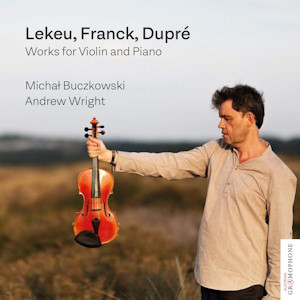
Guillaume Lekeu (1870-1894)
Sonata in G major for piano & violin (1892)
César Franck (1822-1890)
Mélancolie for violin & piano (1886)
Marcel Dupré (1886-1971)
Sonata in G minor for violin & piano, Op. 5 (1909)
Michał Buczkowski (violin)
Andrew Wright (piano)
rec. 2022, Steppenwolf Studio, Asch, Netherlands
Austrian Gramophone AG0028 [60]
The three works here from Belgian-born composers César Franck and Guillaume Lekeu to Frenchman Marcel Dupré span three generations. The most prominent of the composers is Franck, who is associated with both younger composers; Lekeu was his pupil, as was Dupré’s teacher Louis Vierne. Franck and Dupré were renowned organists and all three composers wrote for the organ.
The music world was robbed of a talented composer when Lekeu died of typhoid fever much before his time in 1894 having just turned only twenty-four. I was delighted to discover that he had completed around fifty works – a considerable number in such a short life. In 1885, the fledgling composer Lekeu worked on a violin sonata in D minor but left the score unfinished. Virtuoso violinist Eugène Ysaÿe commissioned a work from Lekeu and in response he provided the three movement violin sonata in G major which was a critical success when premiered in 1893. Lekeu was delighted by the performance and declared that he felt a sense of ‘rapture’ at Ysaÿe’s playing. Considered by many as Lekeu’s most notable work, it has been recorded by prestigious names such as Yehudi Menuhin, Arthur Grumiaux, Augustin Dumay, Tasmin Little, Christian Ferras and Alina Ibragimova, and has proved popular with many other soloists, too.
One senses that soloists Buczkowski and Wright feel completely at home with Lekeu’s G major sonata, a substantial score at thirty-four minutes. Here, the duo provides compelling playing that is highly lyrical, communicating varying levels of sorrowful reflection infusing the score throughout. Taking almost thirteen minutes here, the lengthiest movement is the opening movement Très modéré. A distinct sense of melancholy pervades the writing, leaving an unsettling feel behind. Marked Très lent, the engaging middle movement centres around a folk-like theme. Standing out is the duo’s playing of the Finale: Très animé for its intense yearning quality that is contrasted with vibrant surges of passion.
One of the most famous works for violin and piano in the entire chamber repertoire is César Franck’s violin sonata, a key work in the age of Romantic music. Franck wrote it in 1886 as a wedding present to renowned Belgian violinist, Eugène Ysaÿe who was marrying Louise Bourdeau. In addition to the sonata, Franck wrote a small number of other works for violin and piano, including his Mélancolie. This single-movement score, based on one of his solfège exercises, was begun around 1889 and published in 1911. Compared to Franck’s violin sonata, the Mélancolie may seem inconsequential, yet in the hands of Buczkowski and Wright this lyrical piece, so sweetly reflective, is well worthwhile.
A legendary organist, Marcel Dupré unsurprisingly wrote largely and prolifically for his instrument. However, he did compose in a few other genres, including a handful of chamber works. In 1909 Dupré wrote one of his earliest in that genre, the violin sonata in G minor, Op. 5, published in 1929. This is a high-quality sonata and this account from Buczkowski and Wright is declared to be its first recording. A work of great emotional intensity for its twenty-one-minute duration, it is entirely absorbing. In the opening movement Allegro Buczkowski and Wright provide resolute playing of a passionate and serious disposition with plenty of colour. Marked Andante, the attractive central movement has a sincere and tender quality with a quicker middle section. In the richly lyrical Presto movement that concludes the score Buczkowski and Wright communicate profuse emotional tension.
The recording venue is the Steppenwolf Studio in the Netherlands village of Asch and engineer Slava Poprugin provides high quality sound. Contained in the accompanying booklet is a concise yet reasonably informative essay on each work together with a biographical note on each player.
These are commendable performances of palpable sincerity. With focus and real insight, the partnership play with passion and intensity without resorting to inflated display.
Michael Cookson
Help us financially by purchasing from



















